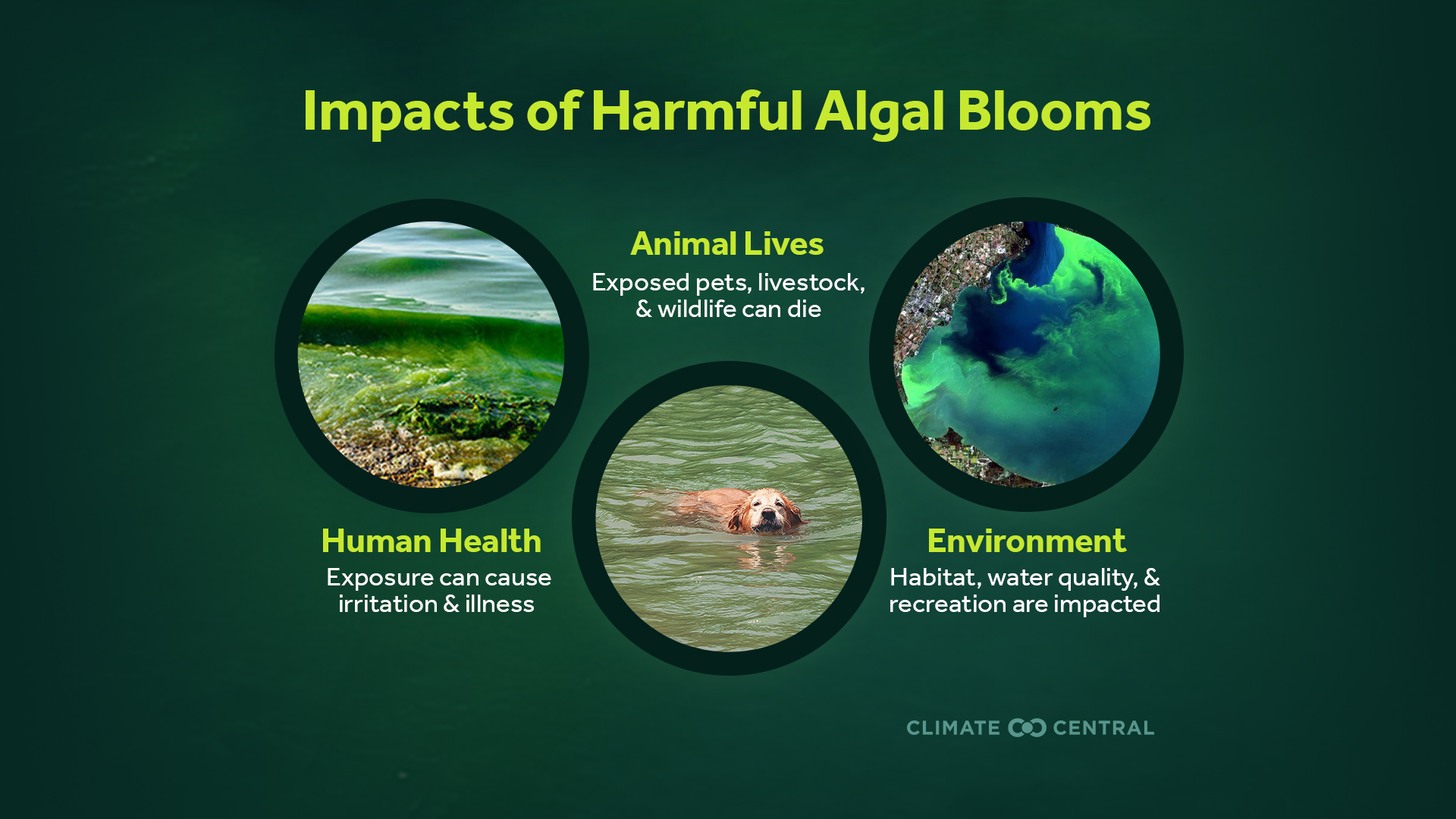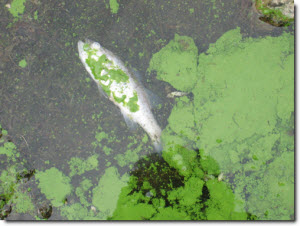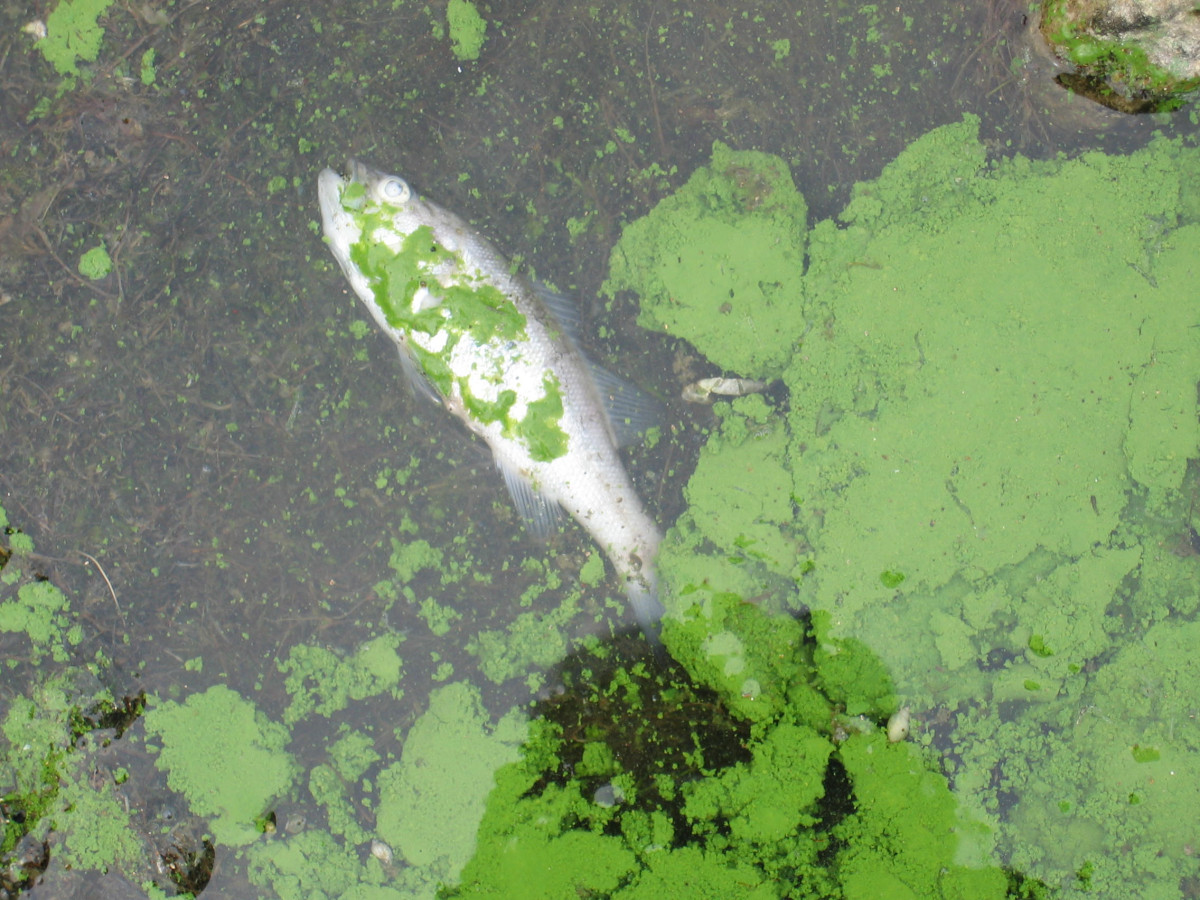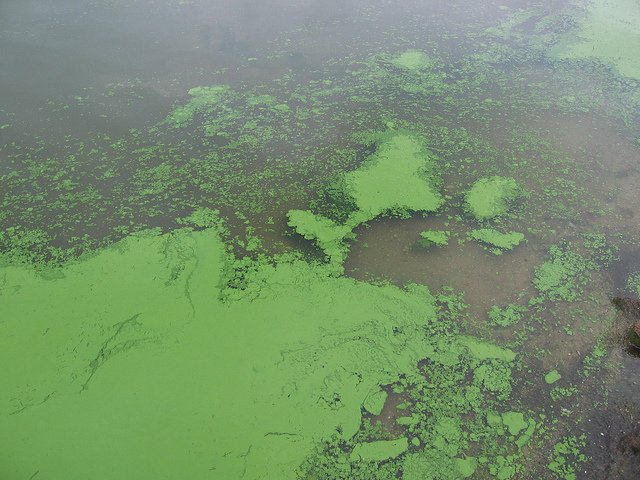Algae that you see, usually multiply and bloom when the water is warm, stagnant, and rich in nutrients (phosphorus and nitrogen) from sources such as fertilizer runoff or septic tank overflows. What is Cyanobacteria?
Cyanobacteria, or blue-green algae, are photosynthetic bacteria found in water. While essential for ecosystems, some species produce toxins, causing harmful algal blooms. Monitoring is crucial to assess water quality and potential risks to the environment and human health.
Freshwater and marine harmful algal blooms (HABs) can occur anytime water use is impaired due to excessive accumulations of algae. In freshwater, the majority of HABs are caused by cyanobacteria (also called blue-green algae). Cyanobacteria cause a multitude of water-quality concerns, including the potential to produce taste-and-odor-causing compounds and toxins that are potent enough to poison animals and humans.
Introduction
Cyanobacteria, often referred to as blue-green algae, hold a significant place in the intricate web of life on our planet. Despite their diminutive size, these microscopic organisms play a crucial role in various ecosystems and have far-reaching impacts on both the environment and human health. In this article, we will delve into the fascinating world of cyanobacteria, exploring their characteristics, ecological importance, and the challenges they pose.
What is Cyanobacteria: Understanding Blue-Green Algae
What are Cyanotoxins
Freshwater and marine harmful algal blooms (HABs) can occur anytime water use is impaired due to excessive accumulations of algae. In freshwater, the majority of HABs are caused by cyanobacteria (also called blue-green algae).
Cyanobacteria cause a multitude of water-quality concerns, including the potential to produce taste-and-odor causing compounds and toxins that are potent enough to poison animals and humans. Taste-and-odor compounds and toxins are of particular concern in lakes, reservoirs, and rivers that are used for either drinking water supplies or full body contact recreation.
Cyanotoxins are a group of toxins produced by certain types of bacteria called cyanobacteria, also known as blue-green algae. These toxins can be harmful to humans, animals, and aquatic life if ingested, inhaled, or in contact with skin. Cyanobacteria are commonly found in freshwater bodies such as lakes, rivers, and ponds, especially in warm, nutrient-rich environments.
There are different types of cyanotoxins, including:
- Microcystins: These are hepatotoxins, meaning they primarily affect the liver. They can cause symptoms such as abdominal pain, nausea, vomiting, diarrhea, and in severe cases, liver damage.
- Anatoxins: Anatoxins are neurotoxins that can affect the nervous system. They can cause symptoms such as muscle twitches, seizures, respiratory paralysis, and even death in severe cases.
- Saxitoxins: Saxitoxins are neurotoxins that can cause symptoms similar to anatoxins. They can lead to paralysis and respiratory failure if ingested in large amounts.
- Cylindrospermopsins: These toxins can affect the liver and kidneys, leading to symptoms such as abdominal pain, nausea, vomiting, and potential long-term health effects.
Exposure to cyanotoxins typically occurs through drinking contaminated water, swimming in or having contact with contaminated water, or inhaling aerosols containing cyanobacteria. Monitoring and management of cyanobacteria blooms in water bodies are important for preventing human and animal exposure to cyanotoxins.
What Does a Cyanobacteria Look Like
Are all Blooms Toxic
Not all blooms of cyanobacteria, also known as blue-green algae, are toxic. Cyanobacteria are capable of producing toxins, but not all species within this group are toxic, and even among toxic species, not all blooms produce toxins.
The toxicity of a cyanobacterial bloom depends on various factors, including the species present, environmental conditions, and the presence of certain nutrients. Some species of cyanobacteria are known to produce toxins under certain conditions, such as
- high nutrient levels
- warm temperatures
These toxins can pose risks to human health, aquatic life, and animals. However, many blooms of cyanobacteria are non-toxic and do not produce harmful toxins. These blooms are still considered a nuisance due to their potential to deplete oxygen in the water and create unpleasant odors, but they do not pose a direct health risk.
It’s essential to monitor cyanobacterial blooms and test for toxins to determine whether they are toxic and pose a risk to human and environmental health. Authorities often issue advisories or warnings when toxic blooms are detected in bodies of water, advising against swimming, drinking, or coming into contact with the contaminated water.
Cyanobacteria: Architects of Earth’s Atmosphere and Blue-Green Algae Fundamentals
If you’re delving into the origins of life on Earth, you’ll inevitably encounter cyanobacteria, a group of photosynthetic microscopic organisms that are technically bacteria. Unlike other bacteria, cyanobacteria wield the unique power of photosynthesis quite similar to plants, which has proved pivotal in the evolutionary narrative. These intriguing microbes are graced with chlorophyll, allowing them to convert sunlight into energy, much like their green plant counterparts.
Departing from their verdant relatives, they boast the bluish pigment phycocyanin, lending them their characteristic blue-green algae hue. In the canvas of Earth’s history, cyanobacteria played a heroic role in sculpting the atmosphere as we know it. Their relentless photosynthetic activities, over billions of years, released vast amounts of oxygen, establishing the foundation for life forms that rely on this vital gas. It’s spellbinding to consider that without these organisms, the Earth’s atmosphere might have taken a drastically different course.
As architects of atmosphere, cyanobacteria’s evolutionary journey underscores their importance beyond just a curiosity in the scientific community. These bacteria are not only masters of oxygenic photosynthesis but also efficient in fixing nitrogen – embedding it in a form palpable for plants to absorb. This dual aptitude positions them as invaluable partners in the web of life, sustaining cycles that keep ecosystems churning. The seemingly inconspicuous life forms, these blue-green algae, are to thank for the breathable air and a habitable planet.
To dismiss them merely as microbes is to overlook the enormity of their impact on Earth’s story of life and evolution. Cyanobacteria, in their quiet corner of the biological world, are unsung giants whose chlorophyll-driven quest for sunlight ingeniously oxygenated our world, and it’s high time we recognize their monumental contribution to our past, present, and future.
The Health Risks of Cyanobacterial Toxins in Water Systems
A pressing concern is the presence of cyanobacterial toxins, also known as cyanotoxins, in drinking water systems. Cyanobacteria, often mistaken for blue-green algae due to their similar appearance, are incredibly resilient organisms that have threaded through the fabric of our planet’s history.
These microorganisms, can release potent toxins that pose serious health risks to animals and humans when they proliferate unchecked. Drinking water contaminated with cyanotoxins can lead to health complications, varying from mild skin irritation to severe neurological disorders. As guardians of public health, it is paramount to monitor and mitigate these risks.
- Hepatotoxins: Some cyanobacteria produce hepatotoxins that can affect the liver, potentially leading to symptoms like nausea, vomiting, abdominal pain, and liver damage.
- Neurotoxins: Certain cyanobacterial toxins act on the nervous system, causing neurological symptoms such as headaches, dizziness, seizures, and respiratory paralysis.
- Skin Irritation: Contact with water containing cyanobacterial toxins may lead to skin irritation, rashes, or allergic reactions.
- Gastrointestinal Issues: Ingesting water or consuming contaminated aquatic organisms can result in gastrointestinal problems, including diarrhea and stomach cramps.
- Respiratory Effects: Inhalation of aerosols from water with cyanobacterial blooms may cause respiratory issues, especially for individuals with pre-existing conditions.
- Long-Term Exposure: Chronic exposure to cyanobacterial toxins has been associated with potential long-term health risks, including increased cancer risk and adverse effects on the immune system.
- Impacts on Pets: Cyanobacterial toxins can also pose health risks to pets, leading to symptoms such as lethargy, vomiting, and even death if ingested.
- Water Supply Concerns: Toxins from cyanobacterial blooms can contaminate drinking water supplies, necessitating careful monitoring and treatment to ensure safe water consumption.

Understanding and addressing the health risks associated with cyanobacterial toxins is crucial for protecting both human and environmental well-being. Regular monitoring of water systems helps mitigate potential impacts and ensures the safety of water resources.
Consuming drinking water imbued with these toxins can trigger acute and chronic health effects. Acute exposures often result in symptoms like nausea, vomiting, and liver inflammation, while chronic exposure might cause more serious issues such as tumor promotion.
The toxicity of these substances underscores the need for robust drinking water treatment protocols and regular monitoring of water bodies for the protection of public health. The primary types of cyanotoxins include microcystins, cylindrospermopsin, saxitoxins, and anatoxins, each with its specific mechanism of action, contributing to the overall damage inflicted on the health of unsuspecting consumers.
Maintaining the sanctity of our drinking water supply is a public health imperative. Vigilant and proactive measures are required to combat the encroachment of these insidious toxins into our water systems. It’s only through the deployment of advanced filtration technologies and persistent surveillance that we can safeguard public health against the hidden threat of cyanobacterial toxin lurking in our drinking water. By facing down these microscopic adversaries, we defend the cornerstone of public health—that is, access to safe, toxin-free drinking water
Monitoring Cyanobacteria Blooms in Freshwater Ecosystems
The continuous monitoring of these blooms enables us to safeguard water systems that are integral to both human health and biodiversity. Freshwater ecosystems—ranging from tranquil ponds to meandering rivers—are nurseries for countless species and are vulnerable to the potentially toxic effects of these algae blooms. Environmental stewardship demands that we consistently track the proliferation of blooms to handle the risks efficiently.
Understanding the cyanobacteria in water systems not only informs us about the current state of aquatic health, but it also prepares us for necessary interventions. Environmental agencies around the globe have ramped up their efforts in monitoring these blooms, recognizing that the defense against environmental harm is predicated on the knowledge of these organisms’ patterns.
By maintaining a watchful eye—whether through satellite imagery, water sampling, or other technological advancements—we’re better positioned to respond when blooms threaten to disrupt the delicate balance of freshwater ecosystems. Consider the environmental cost of ignoring these warning signs: unchecked algae blooms drastically reduce oxygen levels in water systems, suffocating fish and plant life, hence imperiling the entire aquatic food web.
Synechocystis sp: A Model Organism for Studying Cyanobacteria
In the world of scientific research, certain organisms earn the title of a ‘model organism’ for their invaluable contributions to expanding our biological knowledge base. (Synechocystis sp.) a genus of cyanobacteria, is one such distinguished microbe that has become a laboratory staple in the fields of microbiology, genetics, and molecular biology due to its relatively simple genetics and its ability to perform photosynthesis similarly to plants.
- Synechocystis sp. PCC6803 is one of the most highly studied types of cyanobacteria as it can grow both autotrophically or heterotrophically in the absence of light. It was isolated from a freshwater lake in 1968 and grows best between 32 and 38 degrees Celsius.

Synechocystis sp. serves as an exemplary model organism because it’s unicellular, easily manipulated genetically, and its data provides insights that are both rich and applicable across various branches of science, especially when studying the broader cyanobacterial communities.
When it’s about digging into the molecular machinations of photosynthetic machinery, Synechocystis stands out. Utilized extensively in laboratories, this cyanobacterial species has been instrumental in illuminating the photosynthetic process, where research into its genetic makeup has been fundamental in understanding how these organisms convert light into chemical energy.
As a model organism, the robustness of Synechocystis in laboratory conditions makes it a wellspring of information, offering vast amounts of data for scientific scrutiny and reflection. Such research brings to light both the potentials and perils of cyanobacterial proliferation, particularly in reference to the health risks associated with cyanobacterial toxins in water systems.
The beauty of Synechocystis lies not just in its utility for study but also in its contribution to the foundational knowledge of cyanobacterial behavior. Its genetics offers a window into the past, where cyanobacterial ancestors played a pivotal role as architects of Earth’s atmosphere, giving rise to the air we breathe today.
Moreover, the monitoring of Synechocystis can mirror strategies needed for keeping tabs on cyanobacteria blooms in freshwater ecosystems, where their rampant growth can be both a concern for public health and an indicator of ecological imbalance.
Technological Advancements in Detecting Toxins in Blue-Green Algae
The crux of a sustainable environment pivots on the delicate balance of its ecology, and quintessentially, the presence of blue-green algae, or more scientifically termed cyanobacteria, plays a pivotal role within this natural tableau. As we delve into the world of these microscopic building blocks, understanding and managing their toxic byproducts is crucial. It’s here that technological advancements have illuminated the path forward. Cutting-edge technology now permits the detection of toxins with unprecedented precision, safeguarding our vital resources.

Recent advancements in technology have ushered in a new era of detection, wielding sophisticated equipment and sensors dedicated to the task. These tools have revolutionized how we measure and respond to the environmental challenges posed by harmful cyanobacterial blooms.
By leveraging advanced methods, scientists are able to discern the presence of various toxins produced by different strains of cyanobacteria, including the notorious cyanobacterium Synechocystis sp., a model organism covered earlier in our discourse.
The Environmental Protection Agency (EPA) is at the forefront of integrating these technological marvels into their repertoire, ensuring public safety and ecological harmony. By harnessing such resources, environmental monitoring has seen a significant leap. Sensors now dot our water systems, vigilant sentinels poised to alert us at the slightest hint of toxic intruders. With these advancements, detecting toxins borne by blue-green algae has transcended beyond the arcane methods, promising a future where meticulous measurement becomes the steadfast guardian of our environmental sanctum.
This paradigm shift in detection technology reflects a beacon of hope, dispelling the shadows cast by the potential health risks associated with cyanobacterial toxins. Through continuing innovation and dedication, the technological advancements we wield today will define our preparedness tomorrow, ensuring our resources, and by extension, our well-being, remain shielded from the invisible dangers that once lurked unnoticed in the watery realms of blue-green algae.
Strategies for Managing Cyanobacteria and Protecting Public Health
It’s crucial to address algal blooms head-on. The cornerstone of keeping these microscopic gardeners of aqua-fields in check is by adopting comprehensive monitoring methods. Proactive management strategies, coupled with community involvement and regulatory frameworks, are essential for safeguarding public health and mitigating the impacts of cyanobacterial blooms in freshwater ecosystems.
- Early Detection: Implement robust monitoring systems to detect cyanobacterial blooms early, enabling timely response measures.
- Public Education: Conduct awareness campaigns to educate the public about the risks associated with cyanobacteria and provide guidance on safe water practices.
- Water Treatment: Employ water treatment technologies to remove or neutralize cyanobacterial toxins from drinking water supplies, ensuring safe and clean water for consumption.
- Nutrient Management: Implement strategies to manage nutrient inputs into freshwater systems, addressing the root causes of cyanobacterial overgrowth and blooms.
- Regulatory Measures: Enforce and strengthen regulations to control nutrient runoff, promote responsible land use practices, and mitigate factors contributing to cyanobacterial proliferation in water bodies.
Such approaches use cutting-edge technological advancements which are pivotal in detecting toxins produced by cyanobacteria, ensuring that public safety isn’t compromised by these uninvited guests. As stewards of our lakes and reservoirs, we must employ both preventive and responsive measures to protect the matrix of life they support. Prevention strategies range from regulating the nutrients that fuel algal blooms to designing waterscapes that deter cyanobacteria’s unwelcome colonization.
Ultimately, managing this elemental balance of respecting nature’s roles while shielding our communities from its possible wraith. The synergy of scientific insight and practical measures chart a course toward maintaining our lakes as a safe haven for both recreation and biodiversity, rather than allowing them to devolve into toxic quilts that threaten public health. As we continue to cast our nets wide, gathering data and refining our strategies, the war against cyanobacterial blooms is one we can’t afford to lose.
Conclusion:
In conclusion, cyanobacteria are more than just microscopic organisms; they are intricate contributors to the balance of life on Earth. While their ecological importance is undeniable, the challenges they pose necessitate a comprehensive understanding and proactive management. Scientific research continues to unlock the potential of cyanobacteria in various fields, offering a glimpse into the future of sustainable technologies and medical advancements. As we navigate the complexities of coexisting with cyanobacteria, it becomes evident that these tiny warriors hold secrets that could shape the future of our planet.
References:
ScienceDirect- Synechocystis
USGS-Cyanobacterial (Blue-Green Algal) Blooms: Tastes, Odors, and Toxins
FAQ’s
How are cyanobacteria utilized in bioremediation efforts?
- Some cyanobacteria have the ability to absorb and accumulate heavy metals, making them valuable in bioremediation efforts to clean polluted environments.
What role do cyanobacteria play in biofuel production, and how is this potential being explored?
- Researchers are exploring the potential of cyanobacteria in biofuel production. These microorganisms can be engineered to produce biofuels, offering a sustainable alternative to traditional fossil fuels.
What bioactive compounds do cyanobacteria produce, and how are they contributing to medical discoveries?
- Cyanobacteria produce a variety of bioactive compounds with potential pharmaceutical applications. Ongoing research is uncovering their role in developing new drugs and treatment




